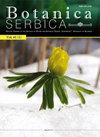杨梅花粉:植物生长调节剂的作用
IF 1.1
4区 生物学
Q4 PLANT SCIENCES
引用次数: 0
摘要
杨梅是一种主要用于园林绿化的树种,最近用于蜂蜜生产。其抗氧化特性也一直是研究的热点。在离体条件下,对鲜花新鲜采集的花粉粒进行了萌发试验,30%蔗糖的花粉萌发率最高。随后,在生长培养基中分别加入3种生长调节剂[24-表油菜素内酯(Ebl)和22S、23s -同油菜素内酯(Hbl)]或双组合(赤霉素+油菜素内酯),在26℃下培养24小时。结果表明,0.01 ppm Hbl和0.001 ppm Hbl处理的发芽率最高,分别为45.47%和26.74%。随后分别用0.001 ppm Ebl、25 ppm GA3和0.1 ppm Ebl处理。随着GA3浓度的增加,发芽率明显下降。组合处理的统计分析表明,与单独施用相比,组合施用生长调节剂降低了发芽率。此外,最低GA3浓度(25 ppm)的效果与油菜素内酯的效果最匹配,而增加GA3浓度的联合处理并没有提高发芽率。以0.1 ppm Hbl处理的发芽率最高,所有Ebl处理次之。油菜素内酯可能是植物花粉萌发的诱导剂,这取决于它们的类型和浓度。当单独加入生长培养基时,高油菜素内酯的诱导程度大于表油菜素内酯。它们与赤霉素的相互作用主要取决于所用赤霉素酸的浓度。表油菜素内酯比高油菜素内酯在保持较高的萌发水平方面更一致。本研究结果表明,需要从其他植物物种的研究中收集更多的信息来阐明油菜素内酯在体外和体内萌发中的作用。本文章由计算机程序翻译,如有差异,请以英文原文为准。
Pollen of Arbutus unedo: Effects of plant growth regulators
Arbutus unedo is a species mainly used for landscaping purposes and lately for honey production. Its antioxidant characteristics have also been a subject of of research interest. The germination of pollen grains freshly collected from flowers was tested in vitro, and 30% sucrose gave the highest pollen germination. Subsequently, three growth regulators belonging to the categories of gibberellins and brassinosteroids [24-epibrassinolide (Ebl) and 22S,23S-homobrassinolide (Hbl)] were added to the growth medium singly or in double combinations (gibberellin + brassinosteroid), and the petri dishes were kept for 24 hours at 26?1?C. The results showed that the highest germination rates were obtained from treatments with 0.01 ppm Hbl (45.47%) and 0.001 ppm Hbl (26.74%). They were followed by treatments with 0.001 ppm Ebl, 25 ppm GA3 and 0.1 ppm Ebl. As the concentration of GA3 increased, the germination rate declined considerably. Statistical analysis of the combined treatments showed that combinations of growth regulators lowered the germination rates compared to their individual application. Moreover, action of the lowest GA3 concentration (25 ppm) best matched the effects of brassinosteroids, and increasing the GA3 concentration in combined treatments did not improve germination. The highest germination was obtained with 0.1 ppm Hbl, followed by all Ebl treatments. Brassinosteroids might be an inducer of pollen germination in plants depending on their type and concentrations. When individually included in the growth medium, the extent of this induction was greater with the homobrassinolide than with the epibrassinolide. Their interactions with gibberellins are shown to be mostly dependent on the concentration of gibberellic acid used. The tested epibrassinolide was more consistent than the homobrassinolide in maintaining higher germination levels. The findings of this study indicate that gathering more information from studies involving other plant species is needed to clarify the role of brassinosteroids in in vitro and in vivo germination.
求助全文
通过发布文献求助,成功后即可免费获取论文全文。
去求助
来源期刊

Botanica Serbica
Agricultural and Biological Sciences-Plant Science
CiteScore
1.40
自引率
12.50%
发文量
17
审稿时长
34 weeks
期刊介绍:
Botanica Serbica publishes original research papers on all aspects of plant, fungal and microbial biology research including the disciplines of microbiology, mycology, lichenology, bryology, flora, vegetation, biogeography, systematics, taxonomy, plant biotechnology, plant cell biology, plant ecology, environmental plant biology, forestry, genomics, horticulture, limnology, metabolomics, molecular biology, proteomics, virology, plant conservation and protection, and wildlife and ecosystem management.
 求助内容:
求助内容: 应助结果提醒方式:
应助结果提醒方式:


